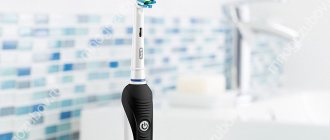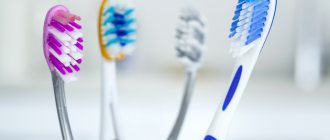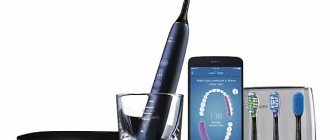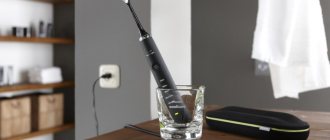Electric toothbrushes are becoming increasingly popular. They allow you to quickly clean your mouth of food debris and remove plaque from your teeth. They are suitable for almost everyone, including small children. Let's try to figure out how to choose the right electric toothbrush and what functions it should have.
Daily hygiene routines can be made easier, faster and more effective by using modern devices, such as an electric toothbrush.
It removes food debris from the oral cavity better than manual dentistry and cleans plaque from tooth enamel. With its help it is possible to prevent the formation of stones, caries, periodontal disease
In this article
- How electric brushes work
- Pros and cons of electric brushes
- Types of electric toothbrushes
- How to choose a toothbrush: selection criteria
- How to choose an electric toothbrush for adults and children
and other dental problems. The main thing is to choose the right device and learn how to use it.
Electric toothbrush: modern models, their features and recommendations for choosing
One of the important aspects in caring for your teeth and oral cavity is the choice of a high-quality brush that meets all criteria and is selected taking into account the current condition of the enamel and gums. Today, electric models have become widely popular. According to the opinions of many experts and users, they cope with their task much better, and a wide range of modifications allows you to find the most suitable option for yourself. In this article we will talk about how to choose an electric toothbrush, what types there are and what characteristics should be used to evaluate quality, efficiency, and safety.
Additional functions
In addition to the main parameters, it is also worth paying attention to less important, but also important functions. When continuing to choose an accessory for brushing your teeth, you should pay attention to its functionality:
- a pressure sensor will help avoid damage to the enamel due to strong pressure on the teeth;
- the liquid crystal screen allows you to control the time of brushing your teeth and the charge level - although the same functions can be performed by a mobile application, to which some modern brushes can connect;
- wear indicator in the form of colored bristles allows you to replace the nozzle in time;
- The disinfection device disinfects the nozzles using UV radiation.
What types of electric brushes are there?
All electric models can be divided into several categories. Moreover, each type has its own characteristics and recommendations for use. Let's look at them in a little more detail.
For mechanical cleaning
Usually it provides a round head with the ability to perform from 5 to 30 thousand reciprocating oscillations of the working area. The handle contains a board that controls the movements of the head. The device can be battery operated or have a battery inside. The estimated cost of a toothbrush of this type varies between 2-5 thousand rubles.
For mechanical cleaning it usually uses a round head
Sound model
In this case, the operating principle of the device is based on the influence of sound vibrations. Such a brush can make about 19 thousand vibrations, due to which the enamel and soft tissues are effectively cleansed from plaque, food debris and bacteria. Such a device will cost from 4 to 8 thousand rubles.
The device is based on the effects of sound vibrations
Ultrasound machine
This is a more advanced and effective option. Ultrasound spreads to the deeper layers of dental tissue, successfully fights plaque and hard deposits, returns teeth to their natural whiteness and does not injure the mucous membrane. This is the most expensive option for home use – 5-10 thousand rubles.
Ultrasound propagates to deeper layers of dental tissues
How to use an electric brush correctly
To maintain healthy teeth and an attractive smile for many years, you need to follow some recommendations.
- The electric brush must be applied to the tooth so that the bristles completely cover its surface.
- During cleaning, there is no need to help the device and move your hand, as when working with a regular brush. The bristles of the electric brush move on their own, so it is enough to apply the brush to your teeth, holding it in this position.
- There is no need to rush into trying to reduce your cleaning time.
- You should not jump from one area to another. First you need to completely clean the outer surface of one row of teeth, then move on to its inner surface and only after that start cleaning the other row of teeth.
This figure clearly shows the rules for brushing your teeth with an electric brush.
Types of nozzles and their characteristics
During your consultation with your dentist, be sure to ask which brush is best to choose in your particular case, and which mode is recommended for you. There are models that perform only horizontal or rotational movements - they are not recommended for cases of hyperesthesia or inflamed gums. If we talk about the overwhelming majority, then the optimal choice would be a model with a round or oval nozzle up to 30 mm in size. In this case, you can choose an option in which the bristles will perform reciprocating movements and sweeping (2D) or reciprocating rotation with vertical pulsation.
Below are the main types of attachments for electrical devices:
- universal – for daily use, with medium-hard bristles,
- bleaching – the pile is treated with a special composition with a bleaching effect, not suitable for permanent use,
- for teeth with increased sensitivity – soft bristles, suitable also for sensitive gums prone to bleeding,
- orthodontic – for braces, multi-level bristles with piles of varying density and diameter,
- for treating interdental spaces - single-tuft, the pile is cut at an angle, used to remove plaque and food debris between teeth, indicated for crowding.
The photo shows the types of attachments
. There are special children's attachments for cleaning the surface of the tongue and mucous membranes, for people with implants, dentures and veneers. In any case, you should talk to your doctor before purchasing.
Sound
In this type of electric toothbrush, the head remains stationary and the bristles themselves move. A special membrane converts the rotation of the electric motor into sound waves. Their vibration is transmitted to the bristles of the brush, which begin to vibrate at high frequency. Thanks to this, a foam of uniform consistency is formed, consisting of toothpaste, air and water - this allows you to effectively and carefully remove plaque even in the most inaccessible places. In this case, double cleaning of the tooth surface occurs - both directly due to the impact of the bristles, and due to the impact of sound waves.
Other advantages can be noted:
- Cleansing occurs gently, without damaging tooth enamel.
- the use of a sonic electric brush does not affect the fastening of braces and veneers, and does not cause fillings to fall out.
- By massaging the gums, blood microcirculation improves.
See also -
18 best curling irons according to customer reviews
Criteria for selecting a suitable model
When studying the range of available options, in order to correctly choose the most suitable model for yourself, it is important to take into account many nuances. To make the task easier, familiarize yourself with the main criteria that you should pay attention to.
Bristle hardness
A sufficient degree of flexibility of the bristles allows for better cleaning of interdental spaces and hard-to-reach places. In addition, due to this feature, the brush provides a massage of the gums, which stimulates blood circulation in the mucous membrane, improves its structure and condition. At the same time, the bristles must be stiff enough to effectively remove plaque and prevent the formation of hard deposits. For healthy teeth and gums, a medium-hard option is suitable.
Head parameters
The size of the work area is also important. In fact, the smaller the head of the device, the better, as it offers more ability to thoroughly treat each individual tooth. This allows you to efficiently clean the spaces between the teeth, where the most bacteria accumulate. Universal parameters are from 18 to 30 mm, but this indicator largely depends on the age of the person. If for children the suitable head size is from 20 to 25 mm, then for adults the preferred size is 30 mm1.
Bristle density and number of tufts
For children, it is recommended to choose models with the number of bundles from 20 to 25 pieces. After a complete change in bite, a teenager can move on to specimens with a number of tufts of up to 40 pieces. For adults, nozzles with 55 tufts are recommended.
On a note! Some modern models of premium brands have one interesting feature. Their pile is treated with a special food coloring - absolutely harmless to the teeth and the body as a whole. This is a kind of indicator: when the paint is completely erased, it will mean that it is time to replace the brush.
To keep the bristles in good condition, after each procedure you should rinse them thoroughly with water and treat them with soap. It is advisable to treat it once a week with a special antibacterial composition.
Operating principle - movement characteristics
Different models provide different modes of movement of the working area of the device. So, there are nozzles that perform reciprocating or pulsating movements. The first option provides more gentle cleansing and is suitable for people with sensitive enamel, as well as children and the elderly. Pulsating specimens transmit vibration in combination with circular movements. They effectively remove plaque and fight deposits, but can injure the mucous membrane and enamel.
The photo shows how the brush works
Presence of a timer
Some units come complete with a built-in timer. This means that the brush itself automatically turns off when the procedure can be considered completed. This is another precautionary measure that protects against accidental damage to the enamel during too long and intense cleaning.
Possibility of adjusting the pressure force
A device with a pressure sensor independently regulates the intensity of rotation of the head, reducing it at the moment of excessive pressure on the teeth. This brush itself slightly deflects the work area when there is too much pressure on the enamel. It costs an order of magnitude more, but provides protection against injury to enamel and gums.
Battery charging
Modern examples can be battery operated or “powered” by a built-in battery. The second option is more convenient, and therefore is considered more preferable. There is no need to regularly buy batteries and ensure their timely replacement. It is enough to charge the device from the electrical network from time to time.
Different models provide different characteristics
Simple and affordable toothbrushes
When you just need to clean your teeth efficiently, it makes sense to choose an inexpensive, practical brush. Below we will talk about modern models from 1200 to 3000 rubles.
Oral-B Vitality 100 Cross Action D100.413.1 Blue
Philips Sonicare CleanCare+ HX3292/28
CS Medica SonicPulsar CS-262
Oral-B Vitality
is the most affordable electric brush in the brand’s adult line. The brush uses 2D Cleaning Action technology: 7600 reciprocating movements per minute. A built-in two-minute timer with 30-second intervals helps you control your brushing time.
The brush has one standard operating mode and one Cross Action nozzle - with cross bristles at an angle of 16 degrees to each other. This arrangement helps to effectively loosen plaque and sweep it out of hard-to-reach places.
The brush works without recharging for up to 12 days. So, Oral-B Vitality is a great option for those who don’t need the bells and whistles and want a simple, high-quality brush.
Philips Sonicare CleanCare
- inexpensive sonic brush.
The smooth relief of the bristles follows the shape of the teeth. The smaller head combined with the angled foot makes it easier to clean hard-to-reach areas. The built-in timer helps you brush your teeth thoroughly without messing around.
If this is your first electric brush, the Easy-start function will help you get used to the new gadget, gradually increasing the pulsation power over 14 days. In total, this brush has one standard operating mode, and comes with one attachment - ProResults Gum Health - to improve the condition of your gums.
The brush works without recharging for up to 17 days.
Philips Sonicare CleanCare is the most affordable in the Philips line and is perfect for getting acquainted with the brushes of this brand.
CS Medica SonicPulsar CS-262
- an electric brush that runs on batteries.
CS Medica, like Oral-B and Philips, has a timer that turns off the brush after two minutes of brushing, and reminds you to change the brushing area every 30 seconds. CS-262 operates in two modes, and the kit includes two standard attachments. Overall, the CS Medica SonicPulsar CS-262 is an affordable toothbrush that doesn’t need to be charged often, just change the batteries periodically. Battery life is up to 150 days. Impressive, isn't it?
Rating of the best brands
Of the variety of brands on the market, there are several devices that have earned special recognition from users and experts. Below is a rating of the most popular manufacturers and models of electric toothbrushes.
Oral-B Professional Care 700 device
Oral-B is one of the leading companies in the production of modern, new generation electric brushes. This model has a standard rounded head shape - for cleaning each tooth one by one. Includes an additional nozzle with colored bristles. Combined technique with almost 9 thousand directed and 20 thousand pulsating movements per minute.
Oral-B Professional Care 700
“I use electric OralBi. In my opinion, it is very convenient and effective. After the morning procedure, your teeth are clean and white, your breath is fresh. There is a pressure sensor, the brush itself does not injure your teeth or scratch your gums. I didn't experience any hypersensitivity. For me personally, this is the best option, at least more effective than a regular plastic brush...”
Sveta78, St. Petersburg, from correspondence on the woman.ru forum
It is recharged via a battery, from a special base that comes included. A pressure sensor is provided to protect against enamel injury. A good option in the mid-price segment.
Kolibree V1 device
The bristles make low-amplitude oscillations - about 15 thousand per minute. It provides one mode, which, nevertheless, copes with its task perfectly. The set includes 2 more attachments, the hardness is medium, some areas are painted with safe food coloring. There is also a built-in timer, battery, Bluetooth, and the ability to connect to a special application on a smartphone to view statistics on the quality of cleaning and the time spent on the procedure.
Kolibree V1
Oral-B Smart 6 6000N
The set includes 3 attachments, all round, designed to treat each tooth separately. There are specimens for whitening, and the device itself provides several modes: delicate, massage, whitening and standard. The movements of the working area are combined: directional - 10.5 thousand per minute, pulsating - 48 thousand per minute. Rechargeable charging and the ability to synchronize with a smartphone via built-in Bluetooth. There is also a pressure sensor and dye on the bristles for timely replacement of the nozzle.
Oral-B Smart 6 6000N
Philips Sonicare DiamondClean model
Option with display and impressive functionality. The set includes 2 standard attachments, several operating modes are provided: massage, whitening, delicate and universal. The brush makes up to 31 thousand movements per minute, and the device itself is charged from the mains via a built-in battery. The display shows information for switching modes and other necessary data for the user. There is a built-in timer that regulates the optimal duration of the procedure.
Philips Sonicare DiamondClean model
Oral-B Genius 9000 brush
The model is presented in 3 color interpretations: white, black and rose gold. There is a built-in timer and pressure sensor. In addition, the device offers the ability to recognize insufficiently cleaned areas. Provides thorough removal of plaque and deposits, as well as gentle gum massage. The set includes 4 attachments: for 3D whitening, softening and removing plaque, treating sensitive areas, removing bacteria and food debris from interdental spaces.
Oral-B Genius 9000
What are bristles made of?
The bristles are made of synthetic bristles - it is inexpensive and very smooth, has a long service life and lacks pores. Heads with natural bristles are produced especially for allergy sufferers, but they have a number of significant disadvantages. First of all, they wear out quickly, so they have a short service life. They are soft, so their cleaning quality is much worse. At the same time, they are significantly more expensive and not very hygienic - natural lint is a breeding ground for the intensive proliferation of bacteria.
Important:
The bristles wear out over time, so the head must be replaced periodically. The need for replacement can be judged by the color of the bristles - as soon as they become dull and faded, it is worth buying a new head. On average, the nozzle needs to be changed every three months.
Depending on the type of electric toothbrush, teeth can be cleaned by moving the head, or by oscillating (vibrating) the bristles themselves (the head itself remains stationary).
There are three types of electric toothbrushes. See also:
What is the difference between a photoepilator and a laser epilator?
Approximate prices
Prices for modern models can vary greatly. The comparison table below shows approximate prices for the brushes described in the rating above.
| Model name | approximate cost |
| Oral-B Professional Care 700 | 5-6 thousand rubles. |
| Kolibree V1 | 10-11 thousand rubles. |
| Oral-B Smart 6 6000N | 14-15 thousand rubles. |
| Philips Sonicare DiamondClean | 16 thousand rubles. |
| Oral-B Genius 9000 | 20 thousand rubles. |
Ultrasonic
The principle of operation of ultrasonic electric brushes generally coincides with the operation of sonic ones. Their fundamental difference is the frequency of vibration of the villi. An electric motor converts electrical energy into high-ultrasonic frequency waves, as a result the device generates from 96 to 192 million vibrations per minute. The depth of propagation of ultrasonic waves from the bristles is no more than 5 mm. Thanks to the vibrations created, tartar and various plaques formed on the teeth - mineralized and pigmented - are effectively destroyed and removed. It also eliminates dirt in even the most hard-to-reach places where the bristles of a regular brush cannot reach. In addition, ultrasound affects microbes, preventing their reproduction.
The use of an ultrasonic electric brush leads to heating of the dental tissue - this can generally be considered a positive thing, because an increase in temperature leads to increased blood circulation in the gums. Other advantages of ultrasonic dental abrasives include:
- the highest quality of teeth cleaning compared to other types of electric brushes.
- economical use of toothpaste.
- The user does not need to make any effort - the brush just needs to be brought to the teeth.
However, the use of ultrasonic electric toothbrushes has a number of limitations:
- bristles vibrating at a very high frequency can cause fillings to fall out due to the destruction of the bonding component.
- Ultrasonic brushes should not be used by pregnant women, people with pacemakers or bleeding gums. In addition, they should not be used by children under 3 years of age, those who have undergone cancer surgery in the oral cavity, or those with high tooth mobility or insufficient enamel density.
- It is not recommended to use ultrasonic electric brushes for people who have crowns, veneers and other structures installed - high vibration frequencies can cause them to break.
Important:
Before purchasing an electric toothbrush, you should always consult your dentist. Which, based on the condition and characteristics of your teeth and oral cavity, will recommend the best option for an electric brush.
See also:
Which iron is better to choose for home use?
Selection tips for children and adults
Choosing a brush for daily brushing of teeth is not an easy task. Before purchasing, you should visit your dentist and consult with him on this issue. Your attending physician will be better able to assess the current condition of the enamel and gums, so his recommendations must be taken into account when choosing a product. Here are some more universal tips from experts in the field of dentistry and hygiene:
- If you have extensive fillings, veneers and crowns in your mouth, it is recommended to give preference to the standard or sound model. Ultrasound propagates to the deep layers of dental tissue and provokes microvibrations, which can lead to the destruction of the binder composition,
- To make cleaning softer and more gentle, you should pay attention to devices with reciprocating oscillations. Vibrating specimens give a more pronounced effect, but act quite intensely,
- for hyperesthesia, soft bristles are prescribed that will not injure the enamel and mucous membranes - according to the doctor’s indications,
- synthetic bristles are better, since bacteria accumulate in natural bristles, plaque settles, and all this can lead to infection of soft tissues, as well as resulting dental diseases.
Children's electric models are suitable for use from 3 years of age.
There are special models for children - lightweight and with a short handle. They are made bright and attractive, with unusual colorful designs. With this brush, brushing your teeth will turn into an exciting game. Children's electric models are suitable for use from 3 years of age. The recommended head rotation speed is no more than 18 thousand per minute. The bristles should be very soft (extra soft) for a child under 5 years old and just soft (soft) if the child is older than this age.
Some modifications for children include corolla bristles. This means that each hair at the end is a small brush of soft but quite elastic fibers. This option is suitable for the most delicate enamel of baby teeth. You can transfer your child to an adult brush after a complete change in bite.
- Ulitovsky S. B. Individual oral hygiene products: electric and manual toothbrushes, 2003.
Operating modes
Most budget brush options only work in one mode. But already for the middle price category, manufacturers provide from 2 to 5 programs. For example, the standard regimen is suitable for any patient with healthy teeth. If you have problems (gum disease or sensitive enamel), you should choose the minimum speed. To whiten teeth, special modes with high intensity vibration or head rotation are used.
The timer allows you to finish brushing your teeth within the recommended time. This function is useful for adults, but can be indispensable for children. Most ultrasonic models emit a signal every half a minute, which is how long it takes to clean half the jaw.
Characteristics
The electric toothbrush consists of:
- Housings;
- Cleaning element;
- Control sensor;
- Motor;
- Storage;
- Sound generator;
- Drive.
The housing houses the drive, charger, sensor and generator. Each of the components is insulated from moisture. Because of this clutter of mechanisms, the body-handle is much more massive than that of ordinary toothbrushes.
Not only the mechanical vibrations of the cleaning head improve the quality of cleaning the oral cavity, but also the dynamic movement of liquid, which, thanks to flows consisting of saliva, water and paste, additionally cleans hard-to-reach areas.
The sound waves emitted by the bristles create additional dynamics. Taken together, all these effects lead to effective cleansing of plaque from the enamel.
Each type of brush requires regular replacement of the cleaning head, as the bristles accumulate pathogenic microbes. This is done once every three months. In addition, additional attachments are used.
Designed for sensitive teeth and bleeding gums. They have a high degree of teeth cleaning compared to regular toothbrushes.
Thanks to the active display, the user knows whether he is pressing the handle correctly, how long it takes to process one area, and when and how to replace components.
Functions of electric toothbrushes:
- Daily 3D cleaning. Allows you to maintain the microbalance of the oral cavity. Thanks to pulsating cleaning technology, it fights germs of any kind and does not harm tooth enamel.
- Cleaning sensitive teeth requires gentle operation of the device itself and a special attachment. The bristles should be of medium length and stiffness.
- The gums are massaged using a special attachment. In addition to the fleecy component, there may be a rubber or silicone insert, which with massage movements will improve blood flow to the gums.
- Teeth polishing is carried out using a sonic type of cleaning. Thanks to sound vibrations, the enamel is cleaned of plaque and protected from the imminent appearance of new ones.
- Deep cleaning is done by an irrigator, which prevents gum problems. Care using such a device is equivalent to professional care.
- Tongue cleaning is carried out thanks to the external side of the cleaning head.
- The motor drives the bristles and head of the toothbrush.
- The pressure sensor detects the force with which your hand presses on the toothbrush.
- Timers to determine when to brush your teeth.
- Reminder function to change the cleaning head.
The standard irrigator kit contains:
- Cleaning head.
- Charger if the model is equipped with a battery.
- If the unit is battery powered, the kit includes prototypes.
Professional cleaning is ensured thanks to a range of attachments:
The standard equipment is complemented by devices that simplify operation:
- Pen holders.
- Travel charger . This accessory is constantly forgotten at home when you go on a business trip or vacation, and the travel charger may always be in your bag. In addition, the road counterpart is smaller in size.
- Covers are used during transportation or even at home. This way the brush is protected from dust and other germs getting onto the surface of the cleaning head. The design of the case is developed in accordance with safety standards to preserve the integrity of the case.
- At home, instead of a cover, special fasteners can be used , with which the device is fixed to the wall. With the help of such a device, space is saved on the bathroom shelves and the brush is securely fastened.
The cleaning head is most often round. Thanks to this shape, you can easily clean hard-to-reach places. The size of the circle does not interfere with cleaning and creates the desired amplitude of vibrations.
Villi on round heads are found:
- straight;
- placed at an angle of 30-40 degrees;
- located at an angle relative to each other.
The oval cleaning head is often found on sonic and ultrasonic models. Thanks to this shape, a sufficient surface area is processed, helping to clean and polish the enamel.
Combination cleaning heads are available in all stores. Thanks to its shaped structure, it produces a multilateral effect on tooth enamel - cleansing and polishing.
Brush charging time and battery life
The estimated time to fully charge the battery is 24 hours. To partially recharge the electric brush, 30 minutes is enough. In this case, the charge level is sufficient for one cleaning.
In offline mode, the devices retain their charge from 20 minutes to 5 hours. This makes it possible to use the product for a whole week without access to the power supply.
The process of using an electric brush










